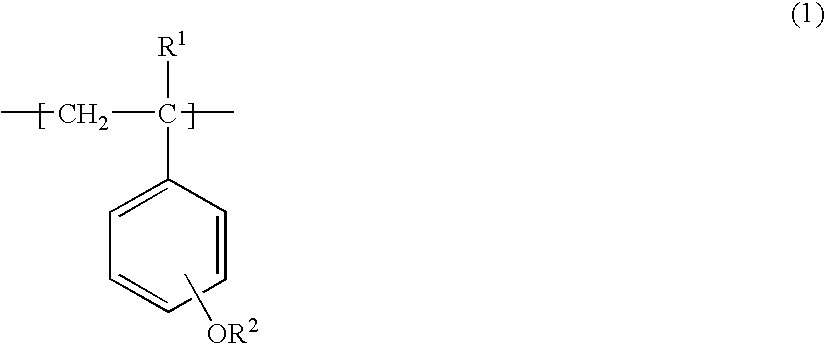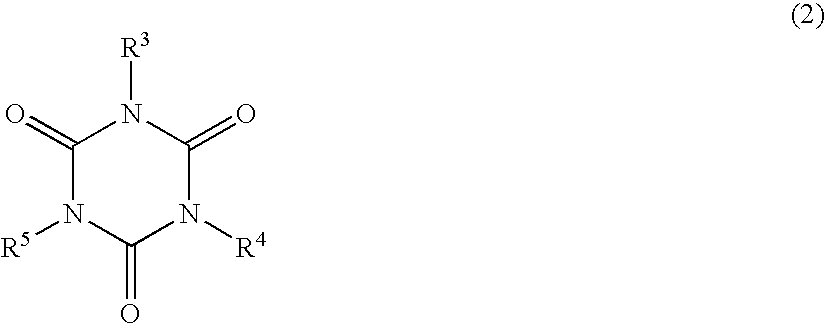Chemically amplified positive photoresist composition for thick film, thick-film photoresist laminated product, manufacturing method for thick-film resist pattern, and manufacturing method for connection terminal
a technology of photoresist composition and composition, which is applied in the direction of photosensitive materials, instruments, photomechanical devices, etc., can solve the problems of difficult to achieve a favorable pattern for the plated product, the metal layer obtained from the plating treatment tends to swell, and the resistance of the photoresist composition to the plating solution is also inadequate, so as to achieve favorable and stable shape, excellent plating step resistance, and favorable formation of resist patterns
- Summary
- Abstract
- Description
- Claims
- Application Information
AI Technical Summary
Benefits of technology
Problems solved by technology
Method used
Image
Examples
synthesis example 1
[0111]A flask equipped with a stirrer, a reflux condenser, a thermometer, and a dropping funnel was flushed with nitrogen, and subsequently charged with propylene glycol methyl ether acetate as a solvent, and stirring of the solvent was then initiated. The temperature of the solvent was then raised to 80° C. The dropping funnel was charged with 2,2′-azobisisobutyronitrile as a polymerization catalyst, 39 mol % of the structural unit represented by the general formula (1) wherein R1 is a hydrogen atom and R2 is a tert-butyloxycarbonyl group as the unit (b1), and 61 mol % of the structural unit hydroxystyrene, and following stirring to dissolve the polymerization catalyst, the resulting solution was added dropwise to the flask at a uniform rate over 3 hours. Reaction was then continued for a further 5 hours at 80° C. to allow the polymerization to proceed. The temperature was then cooled to room temperature, yielding a resin (B-1) with a weight average molecular weight of 10,000 and a...
synthesis example 2
[0112]With the exceptions of using 39 mol % of the structural unit represented by the general formula (1) wherein R1 is a hydrogen atom and R2 is an ethoxyethyl group as the unit (b1), reaction was conducted in the same manner as the synthesis example 1, yielding a resin (B-2) with a weight average molecular weight of 10,000 and a degree of dispersion of 1.5.
synthesis example 3
[0113]With the exception of using 130 parts by weight of 2-methoxyethyl acrylate, 50 parts by weight of benzyl methacrylate, and 20 parts by weight of acrylic acid as the structural units, reaction was conducted in the same manner as the synthesis example 1, yielding an acrylic resin.
[0114]This resin was then fractionated, yielding 6 resins (C-1) to (C-3) with the different weight average molecular weights shown below.
[0115](C-1): weight average molecular weight 250,000
[0116](C-2): weight average molecular weight 350,000
[0117](C-3): weight average molecular weight 450,000
PUM
| Property | Measurement | Unit |
|---|---|---|
| thickness | aaaaa | aaaaa |
| thickness | aaaaa | aaaaa |
| depth | aaaaa | aaaaa |
Abstract
Description
Claims
Application Information
 Login to View More
Login to View More - R&D
- Intellectual Property
- Life Sciences
- Materials
- Tech Scout
- Unparalleled Data Quality
- Higher Quality Content
- 60% Fewer Hallucinations
Browse by: Latest US Patents, China's latest patents, Technical Efficacy Thesaurus, Application Domain, Technology Topic, Popular Technical Reports.
© 2025 PatSnap. All rights reserved.Legal|Privacy policy|Modern Slavery Act Transparency Statement|Sitemap|About US| Contact US: help@patsnap.com



